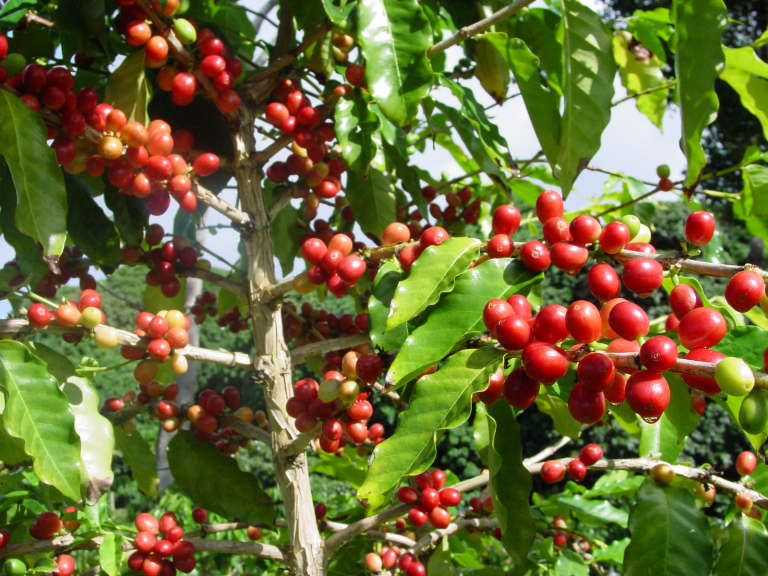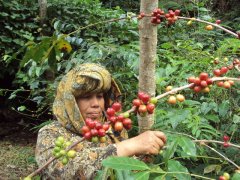Coffee planting technology to share the growth process and planting conditions of coffee the life span of coffee trees is only …

Professional coffee knowledge exchange More coffee bean information Please pay attention to coffee workshop (Weixin Official Accounts cafe_style)
A coffee tree bears fruit several times a year Coffee trees are planted.
This time, we will introduce the whole process of coffee beans from planting to picking, so that everyone can fully understand the process of coffee beans from scratch.
Coffee growing process
seedling stage
The seedling stage is a period from seed germination (or cuttings, grafting) to seedling emergence (nursery seedling stage), about 0.5-1.5 years. After coffee seeds are sown, cotyledons begin to emerge after a period of germination, about 30-100 days, and the length of time is highly correlated with temperature and humidity. After germination, cotyledon seedlings must be moved to nutrient bags for seedling cultivation, which takes 3-12 months to come out of the nursery.
sapling stage
Young tree stage refers to the period from planting to production, about 2-3 years. The main characteristic of this period is vigorous vegetative growth, 6-8 pairs of branches can be drawn every year, with roots, stems and leaves growing as the center, and the above-ground and underground parts expand rapidly to form ideal plant structure and prepare for production.
production period
The initial production period refers to the period from the beginning of production to the arrival of full production. During this period, coffee begins to enter reproductive growth, coffee trees grow vigorously, and nutrient demand is very large.
prolific period
After the initial period of 1-2 years or so into the peak period, coffee trees generally 3- 4 years to bloom, about 2- 3 months each year, appearance and smell similar to jasmine, flowering closely born in clusters, flowering 3- 5 days. After flowering, they bear small green fruit, a few months later mature into red can be picked ripe fruit.
The ripe fruit skin is red, and due to its shape and color similar to cherries, mature coffee fruits are called coffee cherries in many places. Beneath the bright red exocarp are the pericarp, pulp, and a sweet, sticky yellow substance that encases the beans.
Properly managed, it can last for about 30 years.
aging period
Growth decreased year by year, the economic life is approaching the end, coffee trees indicate that entered the aging period. Its life span is closely related to climate, soil and management level, and there are still century-old coffee trees that can bear fruit.
planting conditions
The coffee tree is native to Ethiopia in Africa. Coffee tree in botany, belongs to the Rubiaceae coffee subgenus evergreen tree, and generally known as coffee beans, survey is the coffee tree fruit seeds, only because the shape like beans, so called coffee beans.
Climate is the decisive factor for coffee cultivation. Coffee trees are only suitable for growing in the tropics or subtropics, so the zone between north and south latitudes is most suitable for coffee cultivation. This coffee-producing zone is commonly referred to as the "coffee belt" or "coffee zone."
However, not all the land in this area can produce good coffee trees. The ideal planting conditions for coffee trees are warm climates with temperatures between 15-25 ° C and rainfall of 1500-2000 mm throughout the year, and the rainfall time should match the flowering cycle of coffee trees. Of course, in addition to seasonal and rainfall coordination, there must be fertile soil. The soil most suitable for coffee cultivation is fertile, well drained soil containing pozzolanic matter.
Coffee belt: coffee can not be grown in any environment, because it is originally a tropical rainforest environment of plants, in the development of the system, the need for calm wind, warm, shade or semi-shade and humid environment habits.
Temperature: The requirements for temperature vary with the cultivated species, small species are more cold-resistant, warm and cool climate, requiring an average annual temperature of 19--21.
Rainfall: annual rainfall of more than 1250 mm, evenly distributed, especially in flowering and small fruit development period, there is a certain amount of rainfall most suitable for coffee growth and development.
Light: coffee trees do not tolerate strong light, need appropriate shade, light is too strong, growth is inhibited. If water and fertilizer are insufficient, premature aging and even death will occur. Excessive shade, long foliage, few flowers and fruits, low yield.
Wind: Coffee likes a calm environment.
Soil: coffee tree root system developed, absorption root distribution shallow, loose requirements, fertile, good drainage loam.
Most coffee harvesting in the world is done by hand, so harvesting coffee is a labour-intensive and seasonally intensive process. Since both flowers and fruits are present on the same branch, the picker's index finger and thumb are the best tools for gathering ripe berries. Ripe berries cannot be distinguished from green berries either by scraping them off the entire branch by hand or by using automated harvesting machines.
Coffee farmers who produce low-grade coffee beans prefer to harvest the beans in a labor-saving way, but this reduces the coffee's flavor and grade because of its impure quality. In some parts of Africa, coffee beans are picked by shaking the coffee tree, shaking the fruit off the ground and picking it up before it hurts and rots. Most of Brazil produces secondary coffee, which is harvested by plucking all the leaves, flowers, overheated and green fruit from the branches at once. It takes two years for the damaged coffee trees to recover.
fruit anatomy
These five levels are:
1. Skin/Pulp: The outermost layer of a coffee bean is surrounded by a berry-like skin and pulp. Coffee beans treated by methods other than natural solarization must be peeled and pulped within a few hours of picking. For coffee, the peel and pulp are important byproducts. In some regions coffee is brewed from the skin and pulp. Industry insiders used to call the peel and pulp of coffee "Pulp", and the machine used to remove the pulp was called "Pulp Machine".
2. Mucilage: Under the pericarp and pulp, a thick layer of mucus tightly surrounds the coffee beans. Because this layer of mucous membrane is extremely viscous and high in sugar, people are used to calling it "Honey." Not only coffee, but many fruits have a layer of mucus inside.
3. Parchment: Inside the mucosa, a thin film of cellulose surrounds the coffee beans. After drying, the film looks like parchment, hence the name.
4. Silver Skin (Chaff): There is a thinner film on the inside of the parchment that surrounds the coffee beans. Because of its glossy and silvery color, people are accustomed to calling it "silver skin." This silver skin will peel off during baking. Usually when you grind coffee, you will find some silver particles in the coffee powder. These crumbs are the silver skins that fail to peel off the beans during roasting.
5. Coffee beans: Each fruit contains 2 coffee beans (except for one pod of Peaberry). The fruit of this coffee contains only one coffee bean. Usually, 5% of each batch of coffee beans is a pod of single beans). Coffee beans are dried and processed before roasting.
。
Important Notice :
前街咖啡 FrontStreet Coffee has moved to new addredd:
FrontStreet Coffee Address: 315,Donghua East Road,GuangZhou
Tel:020 38364473
- Prev

Coffee cultivation techniques how to cultivate coffee seeds pruning and fertilization of coffee
Professional coffee knowledge exchange more coffee bean information please follow the coffee workshop (Wechat official account cafe_style) A coffee tree bears fruit several times a year. Coffee is a perennial evergreen shrub of Rubiaceae. At present, there are two kinds of coffee with economic value: Coffea arabica (Arabica) and Coffea canephora (Robusta).
- Next

The common sense of coffee tree planting can coffee trees be planted at home? what are the disasters of coffee trees?
Professional coffee knowledge exchange more coffee bean information please follow the coffee workshop (Wechat official account cafe_style) A coffee tree bears fruit several times a year. Coffee trees grow in the tropics between Tropic of Cancer and Tropic of Cancer and near the equator. There are also great differences in appearance among the so-called world coffee growth zones, caffeine varieties and regional factors. Evergreen
Related
- Beginners will see the "Coffee pull flower" guide!
- What is the difference between ice blog purified milk and ordinary milk coffee?
- Why is the Philippines the largest producer of crops in Liberia?
- For coffee extraction, should the fine powder be retained?
- How does extracted espresso fill pressed powder? How much strength does it take to press the powder?
- How to make jasmine cold extract coffee? Is the jasmine + latte good?
- Will this little toy really make the coffee taste better? How does Lily Drip affect coffee extraction?
- Will the action of slapping the filter cup also affect coffee extraction?
- What's the difference between powder-to-water ratio and powder-to-liquid ratio?
- What is the Ethiopian local species? What does it have to do with Heirloom native species?

